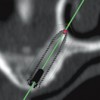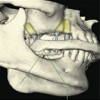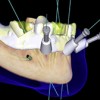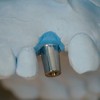Once the laboratory remount is completed a facebow transfer jig is made. The dentures are carefully removed from the master casts, they are finished and polished and remount cast are prepared for both the maxillary and mandibular dentures. The upper denture is mounted onto the articulator using the remount cast and the facebow transfer jig. The dentures are hydrated in preparation for delivery. These procedures are describe and illustrated in this program.
Complete Dentures – Preparing Dentures for Delivery — Course Transcript
- 1. 29 Preparing Dentures for Delivery John Beumer III, DDS, MS Division of Advanced Prosthodontics, Biomaterials and Hospital Dentistry UCLA School of Dentistry This program of instruction is protected by copyright ©. No portion of this program of instruction may be reproduced, recorded or transferred by any means electronic, digital, photographic, mechanical etc., or by any information storage or retrieval system, without prior permission.
- 2. 19. Preparing Dentures for Delivery Fabrication of facebow transfer jig Finish and polish Fabrication of clinical remount casts *Described in this section
- 3. 19. Preparing Dentures for Delivery Fabrication of facebow transfer jig Finish and polish Fabrication of clinical remount casts *Described in this section
- 4. Preparing Dentures for Delivery Fabrication of face bow remount jig Removing Processed Dentures from Master Casts Finishing Polishing Dentures Fabrication of clinical remount casts Mount the maxillary remount cast on the articulator preserving the facebow transfer record
- 5. Fabricate Facebow Remount Jig* Attach processed upper denture with its mounting to the upper member of the articulator and attach a mounting ring to the lower member of the articulator. Fabricate facebow transfer jig as shown. Note that only the occlusal and incisal surfaces of the denture teeth engage the remount jig. Confine the plaster with a paper cup from which the bottom has been removed. Smooth the surfaces of the remount jig because it will be used in the presence of the patient. * The pupose of this jig is to preserve the face bow mounting record.
- 6. Removing Dentures from Casts and Polishing Plaster knife Acrylic Burs Pumice Rag polishing wheels Felt cones Brush wheels Kingsly scraper Instruments and Materials
- 7. Removing Dentures from the Master Casts Make cuts into the base of each cast almost to the resin. Insert the plaster knife into the cuts and carefully separate the sections of stone. On the right a vibrating air hammer is being used to separate the denture from the cast. Remove all stone from dentures. The Kingsley scraper is particularly useful in removing tenacious elements.
- 8. Finishing and Polishing Finish borders with an acrylic bur. Remove excess resin beyond the land. Be careful to preserve the border width and contour. Remove all plaster or stone. Smooth the denture bases to the proper contour with your acrylic burrs. Bubbles and other irregularities around the denture teeth can be removed with chisels or scrapers.
- 9. Remove small particles of stone from the proximal areas with a brush wheel. The palatal portion should 1-2 mm thick . Finishing and Polishing
- 10. Check the bearing surfaces of the dentures for bubbles and sharp projections. Remove such projections with an acrylic burr or the Kingsley scraper. Finishing and Polishing
- 11. Use a very wet rag wheel with liberal amounts of wet pumice to polish the palatal, lingual, labial and buccal areas. The periphery of the denture must also be carefully polished. Use the edge of the wheel as shown during polishing to avoid burning the acrylic resin. Do not overpolish and thereby loose the contours that were developed during festooning. Finishing and Polishing
- 12. Polished dentures Note that the borders are rounded and smooth, and the palate is highly polished and the proper thickness Do not over polish Be careful not to overpolish the occlusal or incisal surfaces of the denture teeth. Finishing and Polishing
- 13. Reexamine the tissue side of the dentures and carefully remove any bubbles present with a Kingsley scraper or other sharp instrument. Finishing and Polishing Prior to delivery the dentures must be soaked in water for 72 hours.
- 14. Fabrication of Remount Casts Purpose: Provide casts with which to mount the clinical remount record
- 15. Remount Casts Begin by blocking out the undercuts associated with the undersurface of the dentures with moistened pumice.
- 16. Remount Casts Mix a small amount of impression plaster, place it on the lab bench and imbed the denture into it as shown .
- 17. Remount Casts After the plaster has set, remove the dentures from the cast, and trim them as shown. The remount casts will be used to mount the clinical remount records on the articulator .
- 18. You are now ready to perform the clinical remount procedure The maxillary remount cast has been connected to the upper member of the articulator by means of the facebow transfer jig. With the lower remount cast you are now ready to perform the clinical remount procedure.


 Prosthodontic Procedures and Complications
Prosthodontic Procedures and Complications
 Angled Implants
Angled Implants
 Computer Guided Treatment Planning and Surgery
Computer Guided Treatment Planning and Surgery
 Cement Retention vs Screw Retention
Cement Retention vs Screw Retention
